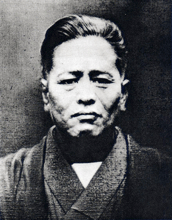
Chojun Miyagi (1888 - 1953)
Among the Okinawan surnames, there are many names that end with Gi, which means "a castle". Once in Okinawa, the word was pronounced Gusuku, thus Chojun's surname was called Miyagusuku then. Chojun was born April 25, 1888 at Naha City. He was born to a pharmacist who had access to the royal family. He was named Matsuu. He, however, was adopted by his uncle who did not have a son as his successor. Chojun was named when he was three years old by the adopted family of Miyagi. Thus his name became Chojun Miyagi.
Starting September 1902, Chojun begun Naha-te practice with Kanryo Higashionna when he was fourteen years of age for three years. In October, 1905, Chojun left for China at the same city Higashionna visited, Fuchou in Fukien province.
The purpose for this trip was to evade the military service tasked by the Japanese government. Ever since the 1868 Reformation, the new Japanese government started to adopt the European parliamentarism as well as legistrative, administrative judicial organization. The first national legislation regarding duty of military service became law in Japan in 1873. Japan copied the system from the French government. According to revised legislation in 1889, any Japanese male citizen between 17 to 40 years of age were all subjected for the duty. The government enforced the law in the prefecture of Okinawa in 1890. On this first visit to the city, Chojun suported himself by making and selling the bomboo ware like Higashionna did. Chojun sold stretchers made of bomboo skins called "Mokko" in Japanese.
It was understandable for Okinawans to be defiant against the Japanese government because they had been the victims of Japanese invasion. Though the Satsuma clan occupied the island in 1609, the clan never took away of the islander's freedom of associating with the Chinese government or maintenance of its monarchic government.
In 1872, the Japanese government decided to rule the island directly and banned the island from associating with China and disbanded the king from his authority.
In 1879, Okinawa became a prefecture of Japan, in which to islanders had no sense of duty being a Japanese citizens. It was common among the islander youth to leave their home for China when they reached seventeen years of age.
However, Chojun experienced extremely difficult times living alone in the foreign city. Though his adopted parents were one of the wealthiest families, it was said that to support Chojun, the family almost lost all of it's fortune. Chojun, in fact, also tried to locate those instructors of Higaonna at the city but he was unsuccesful. Chojun had to come back home in 1908 and volunteered for military service to fulfil his obligation.
After his military service, Miyagi went back again to Fuchou city to locate Chinese instructors from 1915 to 1917. According to his eldest daughter, Tsuru (later named Yasu) his attempt was fruitless because the Chinese were not enthousiastic to cooperate with Chojun for his effort. Fuchou City was also known as a center of underground activists against Manchu government of Chin, after the fall of Ming in 1664. The headquarters of Ten-Chi organization was in that city. All other revolutionary organizations fought against their own government of Manchu, including Japanese, and Western government. The organization was known for its propaganda of "Defy Ching and Obey Ming" or "Destroy Manchu and Reform China". Thus the entire city was quite hostile against foreign tourists like Chojun.
Nevertheless, Chojun did in fact encounter with some local Kung Fu schools and studied Fukien version of Shaolin Chung from time to time though it was not consistant or systematic.
One of the basic training method in the Goju-Ryu called Sanchin starts with clenched fist, on the other hand most Sanchin in Fukien Crane used opened hand. Chojun added a kata form to his school naming it Tensho of which the opening begins with opened hands. It was possible Chojun wanted to introduce another version of Sanchin that he witnessed in China.
With his charismatic personality and devoted commitment to promote the art, Chojun succesfully took leadership in Okinawa for his school that was named Goju-Ryu Karate, meaning Hard and soft style art of Chinese Hand. It was Jinan Arazato, the oldest student of Chojun who named the style Goju-Ryu. It was 1933, in Kyoto, Japan, Arazato represented Chojun and demonstrated Chojun's program at a martial arts events. Japanese martial arts experts suggested to him that claim a school name since it was common for Japanese to present the events identifying their school in the program menu.
Arazato temporarily used the name for that occasion and reported to Chojun about it. Chojun agreed and authorized the name Goju-Ryu and ever since then he used the name for official events. He was the first among the Okinawan Karate leaders who used the school name for the art.
Unlike Kanryo Higashionna, Chojun was built large in physique. The 'writer' recalls his huge hands and their knuckles when he played on Chojun's lap at the age of five and six years old.
The most significant contribution of Chojun to the art was that he introduced the arts at the public schools and organizations such as the police department and athletic institutions.
